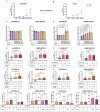Unusual Partners: γδ-TCR-Based T Cell Therapy in Combination with Oncolytic Virus Treatment for Diffuse Midline Gliomas
- PMID: 40076788
- PMCID: PMC11900589
- DOI: 10.3390/ijms26052167
Unusual Partners: γδ-TCR-Based T Cell Therapy in Combination with Oncolytic Virus Treatment for Diffuse Midline Gliomas
Abstract
Due to the minimal survival benefits of existing therapies for pediatric diffuse midline glioma (DMG) patients, new therapeutic modalities are being investigated. Immunotherapies such as CAR-T cells and oncolytic viruses (OVs) are part of these efforts, as evidenced by the increasing number of clinical trials. αβ T cells engineered with a high-affinity γ9δ2 T-cell receptor (TEGs) are immune cells designed to target metabolic changes in malignant or virally infected cells via BTN2A1 and BTN3A. Because the expression of BTN2A1 and BTN3A can be altered in tumor and infected cells, combining TEGs and OVs could potentially enhance the anti-tumor response. We investigated this hypothesis in the following study. We demonstrate that TEGs can indeed target DMG, which expresses BTN2A1 and BTN3A at varying levels, and that OVs can further enhance the expression of BTN3A-but not BTN2A1-in DMG. Functionally, TEGs killed DMG cell cultures, and this killing was further increased after OV infection of the DMGs with either adenovirus Δ24-RGD or reovirus R124 under suboptimal conditions. However, this additive effect was lost when γ9δ2 TCR-ligand interaction was boosted by pamidronate. This study demonstrates the additive effect of combining OVs and Vγ9Vδ2 TCR-engineered immune cells under suboptimal conditions and supports a combination strategy to enhance the efficacy of both therapeutic modalities.
Keywords: ?9?2TCR; D24-RGD; R124; TEGs; diffuse midline glioma; immune-oncology; immunotherapy; oncolytic viruses.
Conflict of interest statement
J.K. is a shareholder of Gadeta. J.K. and P.H.L. are inventors of patents with γδTCR and BTN-related topics. The remaining authors declare no competing interests.
Figures


References
MeSH terms
Substances
LinkOut - more resources
Full Text Sources
Medical

